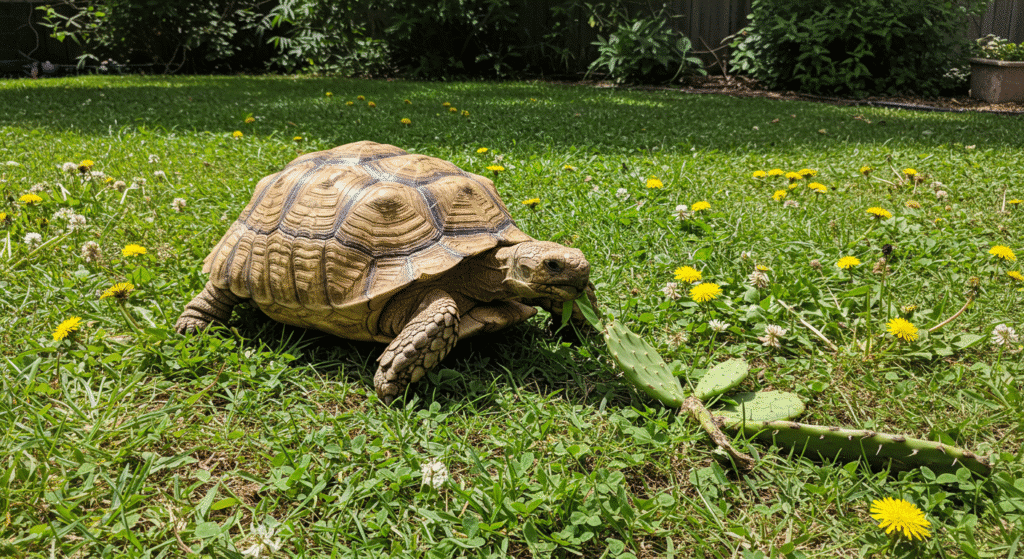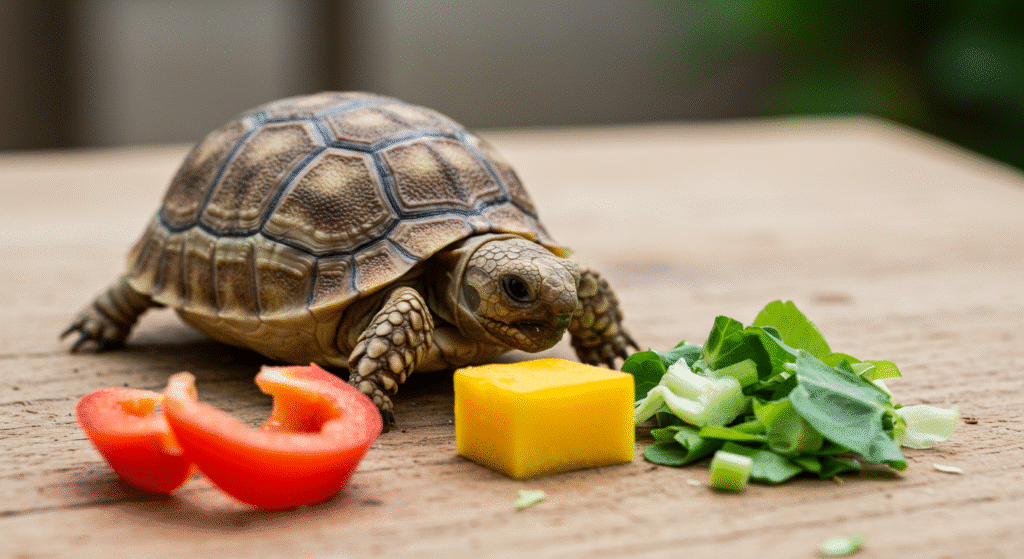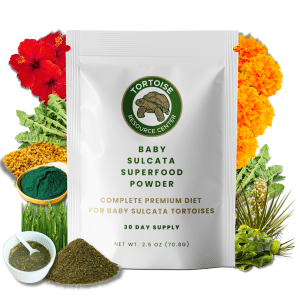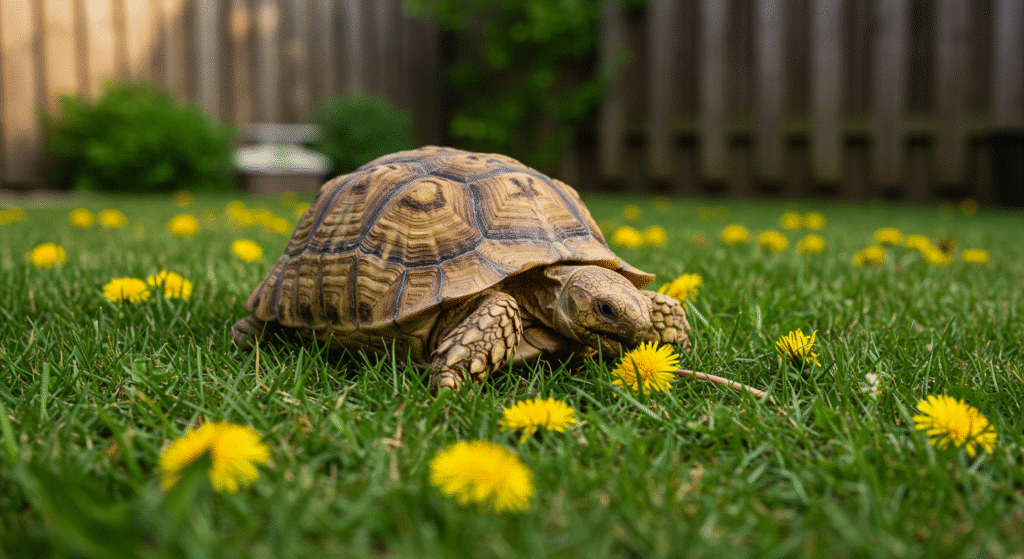What do sulcata tortoises like to eat? If you’ve ever watched your sulcata tortoise carefully select certain foods while completely ignoring others, you’ve discovered something many new keepers don’t expect: these tortoises have distinct food preferences and can be surprisingly picky eaters. Understanding what sulcatas actually enjoy eating—versus what they should eat—is crucial for maintaining both their health and their happiness.
Here’s the challenge: sulcata food preferences don’t always align with optimal nutrition. Your tortoise might love sweet fruits and tender vegetables while showing little interest in the fibrous grasses and weeds that should form the foundation of their diet. This disconnect between preference and nutritional needs creates one of the most common feeding dilemmas for sulcata keepers.
The key to success is understanding both what sulcatas naturally gravitate toward and how to present healthy foods in ways that appeal to their preferences. You need strategies that work with their natural food instincts rather than fighting against them, while still providing the nutrition they need for long-term health.
This guide will show you exactly what sulcatas prefer to eat, why they have these preferences, and how to use this knowledge to create feeding strategies that keep your tortoise both happy and healthy.
Understanding Sulcata Food Preferences in the Wild
To understand what your sulcata likes to eat, it helps to know what they naturally consume in their native habitat. Wild sulcatas are primarily grazers that spend most of their day walking and foraging across the African savanna, consuming whatever edible plants they encounter.
Primary Wild Diet Components:
- Various grass species (50-70% of diet)
- Desert shrubs and bushes
- Seasonal fruits and flowers when available
- Cacti and succulent plants
- Tree bark and fallen leaves during dry seasons
Seasonal Feeding Patterns: Wild sulcatas don’t eat the same foods year-round. During the wet season, they gorge on tender grasses and seasonal fruits. During dry periods, they survive on whatever they can find: dried grasses, tree bark, and stored body fat.

This natural variation explains why your sulcata might show changing food preferences throughout the year, even in captivity with consistent food availability.
What Sulcatas Naturally Prefer
High-Water Content Foods: Sulcatas naturally gravitate toward foods with high water content. This preference evolved in environments where water sources can be scarce, making water-rich plants extremely valuable.
Foods they typically love:
- Melons (watermelon, cantaloupe, honeydew)
- Cucumbers and squash
- Fresh grasses with morning dew
- Prickly pear cactus pads
- Fresh dandelion leaves

What Do Sulcata Tortoises Like to Eat | Options for Feeding
Sweet and Mild Flavors: Like many herbivores, sulcatas show preferences for mildly sweet foods over bitter or strongly flavored options. This is why many tortoises will choose fruit over vegetables when given the choice.
Tender Textures: Young tortoises especially prefer softer, easier-to-chew plant matter over tough, fibrous materials. This can create challenges when trying to introduce appropriate high-fiber foods.
Colorful Options: Many sulcatas show preferences for brightly colored foods—red bell peppers, orange squash, or yellow flowers often attract more interest than dull green vegetables.
Age-Related Food Preferences
Baby Sulcatas (0-12 months): Young sulcatas typically prefer:
- Soft, tender grass shoots
- Finely chopped vegetables
- Water-rich foods like cucumber and squash
- Sweet vegetables like bell peppers and carrots
- Flowers and colorful plant matter
They often reject:
- Tough, mature grasses
- Bitter greens like mustard or turnip leaves
- Large, hard pieces of any food
- Very dry hay or dried plant matter
Juvenile Sulcatas (1-3 years): As they mature, preferences begin expanding:
- More interest in varied grass types
- Better acceptance of bitter greens
- Increased appetite for larger food pieces
- Growing interest in textural variety
Adult Sulcatas (3+ years): Adult preferences are most flexible:
- Acceptance of tough, fibrous plant matter
- Tolerance for bitter or strong flavors
- Ability to process large, challenging food items
- Interest in seasonal variety
Preferred Foods by Category
Grasses (Should be 50-60% of diet): Most preferred:
- Bermuda grass (young, tender shoots)
- Timothy grass (fresh or lightly soaked hay)
- Orchard grass (when young and green)
- Wheat grass (always popular)
Less preferred but important:
- Mature grass hays
- Dried grass varieties
- Very fibrous grass stems
Vegetables (20-30% of diet): High preference:
- Bell peppers (especially red and yellow)
- Squash varieties (butternut, yellow, zucchini)
- Sweet potatoes (small amounts)
- Carrots (grated or chopped)
- Cucumber (though low nutrition)
Moderate preference:
- Collard greens
- Mustard greens
- Turnip greens
- Endive and escarole
Weeds and Wild Plants (10-20% of diet): Usually loved:
- Dandelion (entire plant including flowers)
- Plantain
- Clover (fresh plants)
- Prickly pear cactus pads
Variable acceptance:
- Thistle
- Wild grasses
- Seasonal wildflowers
Occasional Treats (5% maximum): Almost always preferred:
- Strawberries
- Grapes (seedless)
- Apple slices (no seeds)
- Hibiscus flowers
- Rose petals (pesticide-free)

Using Preferences to Improve Nutrition
The Mix Strategy: Combine preferred foods with less favored but nutritionally important options. Chop preferred sweet vegetables with required bitter greens, or mix favorite fruits into grass hay to increase acceptance.
Presentation Techniques:
- Vary food shapes and sizes to maintain interest
- Present foods at different times of day when appetite varies
- Use colorful, attractive arrangements
- Offer foods at optimal temperatures (slightly warm is often preferred)
Seasonal Rotation: Rotate through preferred foods seasonally to maintain interest while ensuring nutritional variety. This mimics natural feeding patterns and prevents boredom.
Gateway Foods: Use highly preferred foods as “gateway” options to introduce new, healthier choices. Once your tortoise accepts one type of grass, gradually introduce other varieties.
Are You Starving Your Tortoise?
Save 10% on premium tortoise food and supplements from Tortoise Resource Center on Amazon now using code BUYNOWGET10

Sulcata Vitamin & Mineral Topper Supplement
30-Day Supply | 2 oz (56 g)
$24.99

Baby Sulcata Tortoise Superfood Powder
30-Day Supply | 2.5 oz (70.8 g) Bag
$24.99
Supporting Healthy Preferences with Quality Nutrition
While working with your sulcata’s natural preferences, ensure they’re getting complete nutrition. Our Baby Sulcata Superfood Powder can be lightly dusted on preferred foods to boost nutritional value without changing taste significantly, making it easier to maintain proper nutrition even when your tortoise is being selective.
For comprehensive mineral support that enhances any diet, our Vitamin and Mineral Topper provides essential nutrients that support healthy food preferences and proper metabolism, helping ensure your tortoise makes the most of whatever foods they choose to eat.
Encouraging Acceptance of Less Preferred Foods
Gradual Introduction: Introduce new or less preferred foods slowly, mixing small amounts with established favorites. Gradually increase the proportion of new foods over several weeks.
Texture Modifications: Make tough or fibrous foods more appealing by:
- Chopping into smaller pieces
- Lightly soaking dried items to soften
- Mixing with water-rich foods
- Serving at slightly warm temperatures
Timing Strategies: Offer less preferred but nutritionally important foods when your tortoise is hungriest—typically in the morning after basking or before their regular feeding time.
Environmental Influences: Food preferences can be influenced by environmental conditions. Some tortoises show better acceptance of varied foods when:
- Humidity levels are optimal
- They’ve had adequate exercise
- Stress levels are low
- Temperatures are in their preferred range
Individual Personality and Food Preferences
The Adventurous Eater: Some sulcatas are naturally curious about new foods and will try almost anything offered. These tortoises are generally easier to maintain on nutritionally optimal diets.
The Picky Eater: Other tortoises are naturally conservative and may resist new foods or show strong preferences for familiar options. These individuals require more patience and strategic introduction of new foods.
The Seasonal Changer: Many sulcatas show changing preferences throughout the year, even in controlled environments. They might love certain foods during some months while showing no interest during others.
The Habitual Feeder: Some tortoises develop strong preferences for specific foods or feeding routines and resist changes. These individuals benefit from very gradual diet modifications.
Preference-Based Feeding Strategies
Daily Preference Management:
- Start meals with less preferred but nutritionally essential foods
- Follow with moderate preference items
- End with small amounts of highly preferred treats
- This ensures important nutrition is consumed while maintaining meal satisfaction
Weekly Variety Planning: Plan weekly menus that include:
- 2-3 highly preferred foods to ensure eating
- 3-4 moderately preferred nutritious options
- 1-2 new or less preferred foods for variety
- Appropriate ratios of grasses, vegetables, and other plant matter
Seasonal Menu Adjustments: Adjust food offerings based on seasonal preferences:
- Spring: Take advantage of increased appetite for fresh growth
- Summer: Emphasize water-rich foods during hot weather
- Fall: Maintain nutrition as activity levels may decrease
- Winter: Focus on maintaining consistent intake with preferred options
Common Preference-Related Problems
Problem #1: Fruit Addiction Many sulcatas develop preferences for sweet fruits that can lead to poor nutrition if not managed properly.
Solution: Use fruit as a gateway to introduce healthier options, gradually reducing fruit portions while increasing vegetable and grass intake.
Problem #2: Vegetable-Only Eating Some tortoises prefer vegetables over the grasses that should form their diet foundation.
Solution: Mix preferred vegetables with increasing amounts of appropriate grasses, gradually shifting the ratio toward optimal nutrition.
Problem #3: Texture Aversion Young tortoises may refuse appropriately fibrous foods due to texture preferences.
Solution: Gradually transition from soft to more textured foods over several months, respecting developmental readiness.
Problem #4: Seasonal Appetite Loss Some tortoises show dramatic preference changes or appetite loss during certain seasons.
Solution: Focus on maintaining nutrition with highly preferred foods during difficult periods while monitoring for health issues.
Working with Natural Feeding Behaviors
Grazing Behavior: Sulcatas naturally graze throughout the day rather than eating large meals. Support this by:
- Offering smaller, more frequent meals
- Providing longer-lasting foods like hay that encourage natural grazing
- Creating feeding opportunities that require some foraging effort
Selective Feeding: Wild sulcatas naturally select the most nutritious parts of plants first. In captivity, this can be supported by:
- Offering whole plants when possible (dandelions, grass clumps)
- Varying food preparation to allow natural selection
- Providing foods at different stages of ripeness or freshness
Social Feeding: If keeping multiple tortoises, understand that feeding preferences can be influenced by social dynamics. Some individuals may eat foods they normally avoid if they see others eating them.

Creating Long-Term Feeding Success
Patience with Preference Development: Food preferences can take time to develop or change. Don’t give up on nutritionally important foods after just a few rejections—it may take weeks or months for acceptance.
Flexibility in Approach: Be willing to adjust your feeding strategies based on your individual tortoise’s preferences and responses. What works for one sulcata may not work for another.
Health-First Perspective: While respecting preferences is important for feeding success, never compromise essential nutritional requirements. Find creative ways to provide necessary nutrition within your tortoise’s preference framework.
Professional Guidance: If your sulcata develops such strong preferences that nutritional needs can’t be met, consult with a reptile veterinarian for specialized feeding strategies.
The Balance of Preference and Nutrition
Successfully feeding a sulcata tortoise requires balancing their natural food preferences with their nutritional needs. This isn’t always easy, but it’s essential for long-term health and quality of life.
The key is working with your tortoise’s preferences rather than against them, using their natural food instincts to support healthy eating habits. When you understand what your sulcata naturally wants to eat and why, you can create feeding strategies that satisfy both their preferences and their nutritional requirements.
Your sulcata’s food preferences are part of their individual personality and natural instincts. By respecting these preferences while guiding them toward optimal nutrition, you can create a feeding routine that keeps your tortoise happy, healthy, and well-nourished for decades to come.
Remember, the goal isn’t to force your tortoise to eat foods they dislike, but to find ways to make nutritionally appropriate foods appealing and satisfying. With patience, creativity, and understanding of natural preferences, you can achieve feeding success that benefits both you and your tortoise for years to come. Want to learn more? Download our sulcata care bonus pack today

